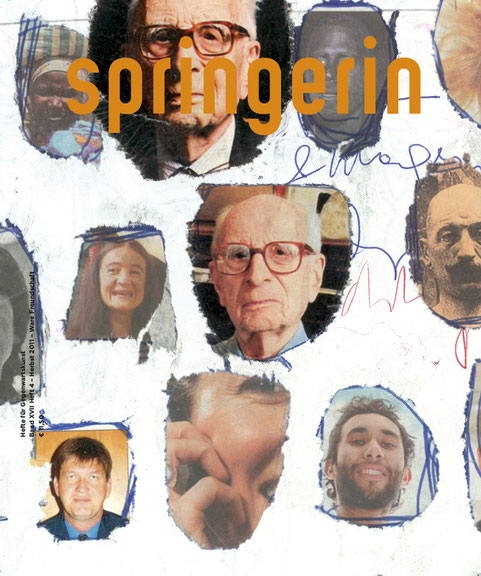Issue 4/2011
»Good« Friendship
»Like«. This label, which is spreading like wildfire nowadays, has come to epitomise a new culture of friendship and friendliness. Liking or enjoying something is increasingly not a matter of subjective aesthetic taste, but has instead become a central interface of commonality transmitted through media channels. In this context friendship is not so much an extension of the individual ego into the social realm but instead, conversely, a kind of relay by means of which the cultural (and everything pertaining to the culture industry) connects its subjects to each other. In this respect the figure of over 800 million active users of the social network Facebook sends a clear message – even if there is still much racking of brains as to the kind of friendship that is now being implemented all over the world. In any event this syndrome does appea... » read more
Net section
My borrowed friends and I
Platforms, better than television
Jana Herwig
Distraction from the Real?
The video-book »Learning from YouTube« by Alexandra Juhasz
Sandra Groll, Marc Ries
Über die Mauer springen
Vera Tollmann
Tricky brains
Pieter T’Jonck
Digital archive – analogue accessories
The opening of the Lygia Clark Art Center in Rio de Janeiro
Max Jorge Hinderer
Architectural/Auditory Attraction
The Project »The Morning Line« Stops Over in Vienna
Roland Schöny
»Good« Friendship
The friendship dimension
Against the commodification of social relationships
Jan Verwoert
The Terror of Positivity
An Interview with the Philosopher and Media Theorist Byung-Chul Ha
Vera Tollmann
Bernhard Fruehwirth. Bildstrecke
Bernhard Fruehwirth
(Multiple) Identities in Social Networks
Alessandro Ludovico
When friendship gets gamified
Daphne Dragona
Eastern enlargement to the East
The Polish collective Krytyka Polityczna is currently expanding into the Ukraine and Russia: but is its Polish success story really transferable?
Herwig G. Höller
Connections, Networks and Alliances
On the Relevancy of the Term »Networking« in the Arts – An Interview with Ulf Wuggenig
Pascal Jurt
Iceploitation
Hanne Hammer Stien
Whose nostalgia is Ostalgia?
An Eastern Europe and Former Soviet Republics survey exhibition in the New Museum, New York
Edit András
Artscribe
»Museum of Parallel Narratives. In the Framework of L’Internationale«
Juliane Debeusscher
Henrik Olesen »How Do I Make Myself a Body?«
Rachel Mader
Geissler/Sann »volatile smile. Ein uneinschätzbares Lächeln«
Michael Hauffen
»Communitas. Die unrepräsentierbare Gemeinschaft«
Christian Höller
»désertieren«
Julia Wallnöfer
Doris Salcedo »Plegaria Muda«
Sophie Goltz
»Sense and Sensibility«
Monika Vykoukal
»Die Chronologie der Teresa Burga. Berichte. Diagramme. Intervalle/29.9.11«
Karin Jaschke
»Beziehungsarbeit/Kunst und Institution«
Walter Seidl
Jan Švankmajer »Das Pendel, die Grube und andere Absonderlichkeiten«
Christa Benzer
Inés Lombardi »Past Present – Close and Distant«
Hedwig Saxenhuber
Books
Wolfgang Müller:
Die Elfe im Schlafsack, Valeska Gert, Kosmas
Barbara Eder
Beate Fricke, Markus Klammer, Stefan Neuner:
Bilder und Gemeinschaften. Studien zur Konvergenz von Politik und Ästhetik in Kunst, Literatur und Theorie
Naoko Kaltschmidt
Sarah Glidden:
Israel verstehen – in 60 Tagen oder weniger«
Martin Reiterer
Claudia Reiche:
Digitale Körper, geschlechtlicher Raum Das medizinische Imaginäre des »Visible Human Project
Gabriele Werner
Katharina Pewny:
Das Drama des Prekären. Über die Wiederkehr der Ethik in Theater und Performance
Susanne Karr
